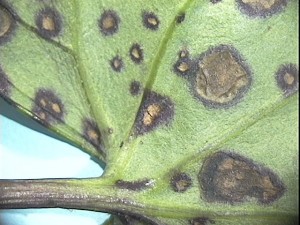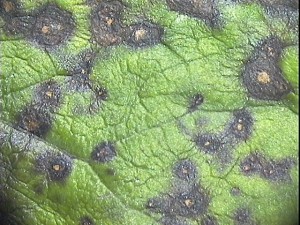Alternaria
Pathogen: Alternaria spp.
Hosts: There are several species of Alternaria that are pathogenic on perennials. Together they have a wide host range including Aster, Calendula, Coreopsis, Dianthus, Gypsophila, Helianthus, Iris, Ligularia, Pelargonium, Platycodon, Shasta, and Stokesia.
Symptoms: Dark colored leaf spots, lesions may have concentric rings within the lesion. Spots may coalesce, resulting in blighting of foliage. Petals of some plants may be infected. Flower buds of Dianthus can be rotted.
Spread: Spores are produced on the plant surface and are spread by splashing water, air movement or by moving infected plant material.
Management: Maintain adequate plant spacing to allow for good aeration to reduce humidity levels around plants. Alternaria spp. require leaf wetness for germination and infection; reduce durations of leaf wetness periods with good timing of overhead irrigation. Regular fungicide applications will likely be necessary to reduce losses on especially susceptible hosts.





 Print
Print Email
Email




